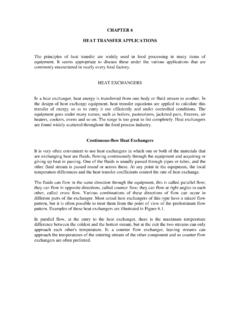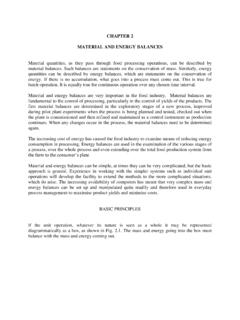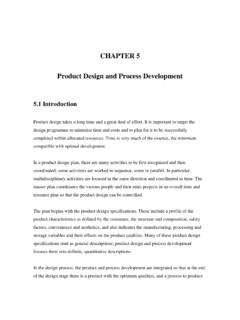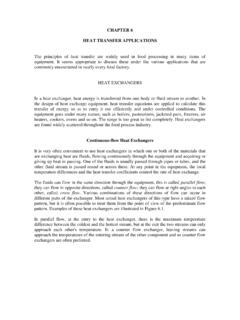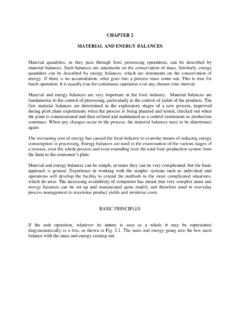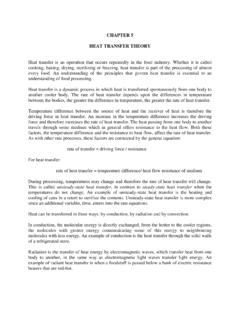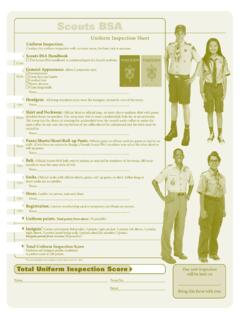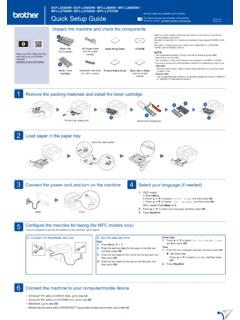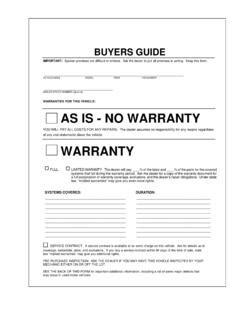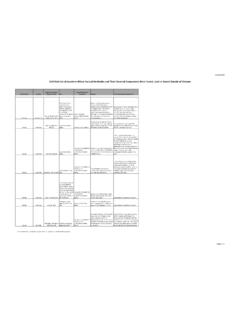Transcription of CHAPTER 7 DRYING - NZIFST
1 CHAPTER 7 DRYING DRYING is one of the oldest methods of preserving food. Primitive societies practised the DRYING of meat and fish in the sun long before recorded history. Today the DRYING of foods is still important as a method of preservation. Dried foods can be stored for long periods without deterioration occurring. The principal reasons for this are that the microorganisms which cause food spoilage and decay are unable to grow and multiply in the absence of sufficient water and many of the enzymes which promote undesired changes in the chemical composition of the food cannot function without water. Preservation is the principal reason for DRYING , but DRYING can also occur in conjunction with other processing. For example in the baking of bread, application of heat expands gases, changes the structure of the protein and starch and dries the loaf.
2 Losses of moisture may also occur when they are not desired, for example during curing of cheese and in the fresh or frozen storage of meat, and in innumerable other moist food products during holding in air. DRYING of foods implies the removal of water from the food. In most cases, DRYING is accomplished by vaporizing the water that is contained in the food, and to do this the latent heat of vaporization must be supplied. There are, thus, two important process-controlling factors that enter into the unit operation of DRYING : (a) transfer of heat to provide the necessary latent heat of vaporization, (b) movement of water or water vapour through the food material and then away from it to effect separation of water from food. DRYING processes fall into three categories: Air and contact DRYING under atmospheric pressure. In air and contact DRYING , heat is transferred through the foodstuff either from heated air or from heated surfaces.
3 The water vapour is removed with the air. Vacuum DRYING . In vacuum DRYING , advantage is taken of the fact that evaporation of water occurs more readily at lower pressures than at higher ones. Heat transfer in vacuum DRYING is generally by conduction, sometimes by radiation. Freeze DRYING . In freeze DRYING , the water vapour is sublimed off frozen food. The food structure is better maintained under these conditions. Suitable temperatures and pressures must be established in the dryer to ensure that sublimation occurs. BASIC DRYING THEORY Three States of Water Pure water can exist in three states, solid, liquid and vapour. The state in which it is at any time depends on the temperature and pressure conditions and it is possible to illustrate this on a phase diagram, as in Fig. Figure Phase diagram for water If we choose any condition of temperature and pressure and find the corresponding point on the diagram, this point will lie, in general, in one of the three labelled regions, solid, liquid, or gas.
4 This will give the state of the water under the chosen conditions. Under certain conditions, two states may exist side by side, and such conditions are found only along the lines of the diagram. Under one condition, all three states may exist together; this condition arises at what is called the triple point, indicated by point O on the diagram. For water it occurs at and kPa ( mm of mercury) pressure. If heat is applied to water in any state at constant pressure, the temperature rises and the condition moves horizontally across the diagram, and as it crosses the boundaries a change of state will occur. For example, starting from condition A on the diagram adding heat warms the ice, then melts it, then warms the water and finally evaporates the water to condition A'. Starting from condition B, situated below the triple point, when heat is added, the ice warms and then sublimes without passing through any liquid state.
5 Liquid and vapour coexist in equilibrium only under the conditions along the line OP. This line is called the vapour pressure/temperature line. The vapour pressure is the measure of the tendency of molecules to escape as a gas from the liquid. The vapour pressure/temperature curve for water is shown in Fig. , which is just an enlargement for water of the curve OP of Fig. Figure Vapour pressure/temperature curve for water Boiling occurs when the vapour pressure of the water is equal to the total pressure on the water surface. The boiling point at atmospheric pressure is of course 100oC. At pressures above or below atmospheric, water boils at the corresponding temperatures above or below 100oC, as shown in Fig. for temperatures below 100oC. Heat Requirements for Vaporization The energy, which must be supplied to vaporize the water at any temperature, depends upon this temperature.
6 The quantity of energy required per kg of water is called the latent heat of vaporization, if it is from a liquid, or latent heat of sublimation if it is from a solid. The heat energy required to vaporize water under any given set of conditions can be calculated from the latent heats given in the steam table in Appendix 8, as steam and water vapour are the same thing. EXAMPLE Heat energy in air DRYING A food containing 80% water is to be dried at 100oC down to moisture content of 10%. If the initial temperature of the food is 21oC, calculate the quantity of heat energy required per unit weight of the original material, for DRYING under atmospheric pressure. The latent heat of vaporization of water at 100oC and at standard atmospheric pressure is 2257kJkg-1. The specific heat capacity of the food is kJkg-1oC-1 and of water is kJkg-1oC-1. Find also the energy requirement/kg water removed.
7 Calculating for 1 kg food Initial moisture = 80% 800g moisture are associated with 200 g dry matter. Final moisture = 10 %, 100g moisture are associated with 900 g dry matter, Therefore (100 x 200)/900g = moisture are associated with 200 g dry matter. 1kg of original matter must lose (800 - 22) g moisture = 778 g = kg moisture. Heat energy required for 1kg original material = heat energy to raise temperature to 100oC+ latent heat to remove water = (100 - 21) x + x 2257 = + = 2056kJ. Energy/kg water removed, as 2056 kJ are required to remove kg of water, = 2056 = 2643kJ. Steam is often used to supply heat to air or to surfaces used for DRYING . In condensing, steam gives up its latent heat of vaporization; in DRYING , the substance being dried must take up latent heat of vaporization to convert its liquid into vapour, so it might be reasoned that 1kg of steam condensing will produce 1kg vapour.
8 This is not exactly true, as the steam and the food will in general be under different pressures with the food at the lower pressure. Latent heats of vaporization are slightly higher at lower pressures, as shown in Table In practice, there are also heat losses and sensible heat changes that may require to be considered. TABLE LATENT HEAT AND SATURATION TEMPERATURE OF WATER Absolute Latent heat of Saturation Pressure vaporization temperature (kPa) (kJkg-1) (oC) 1 2485 7 2 2460 18 5 2424 33 10 2393 46 20 2358 60 50 2305 81 100 2258 (1 atm) 2257 100 110 2251 102 120 2244 105 200 2202 120 500 2109 152 EXAMPLE Heat energy in vacuum DRYING Using the same material as in Example , if vacuum DRYING is to be carried out at 60oC under the corresponding saturation pressure of 20kPa abs.
9 (or a vacuum of kPa), calculate the heat energy required to remove the moisture per unit weight of raw material. Heat energy required per kg raw material = heat energy to raise temperature to 60oC + latent heat of vaporization at 20 kPa abs. = (60 - 21) x + x 2358 = + = 1983kJ. In freeze DRYING the latent heat of sublimation must be supplied. Pressure has little effect on the latent heat of sublimation, which can be taken as 2838 kJ kg-1. EXAMPLE Heat energy in freeze DRYING If the food in the two previous examples was to be freeze dried at 0oC, how much energy would be required per kg of raw material, starting from frozen food at 0oC? Heat energy required per kg raw material = wt. of water vaporised x latent heat of sublimation = x 2838 = 2208kJkg-1. Heat Transfer in DRYING We have been discussing the heat energy requirements for the DRYING process.
10 The rates of DRYING are generally determined by the rates at which heat energy can be transferred to the water or to the ice in order to provide the latent heats, though under some circumstances the rate of mass transfer (removal of the water) can be limiting. All three of the mechanisms by which heat is transferred - conduction, radiation and convection - may enter into DRYING . The relative importance of the mechanisms varies from one DRYING process to another and very often one mode of heat transfer predominates to such an extent that it governs the overall process. As an example, in air DRYING the rate of heat transfer is given by: q = hsA(Ta Ts) ( ) where q is the heat transfer rate in Js 1, hs is the surface heat-transfer coefficient Jm-2s-1oC-1, A is the area through which heat flow is taking place, m2, Ta is the air temperature and Ts is the temperature of the surface which is DRYING , oC.
